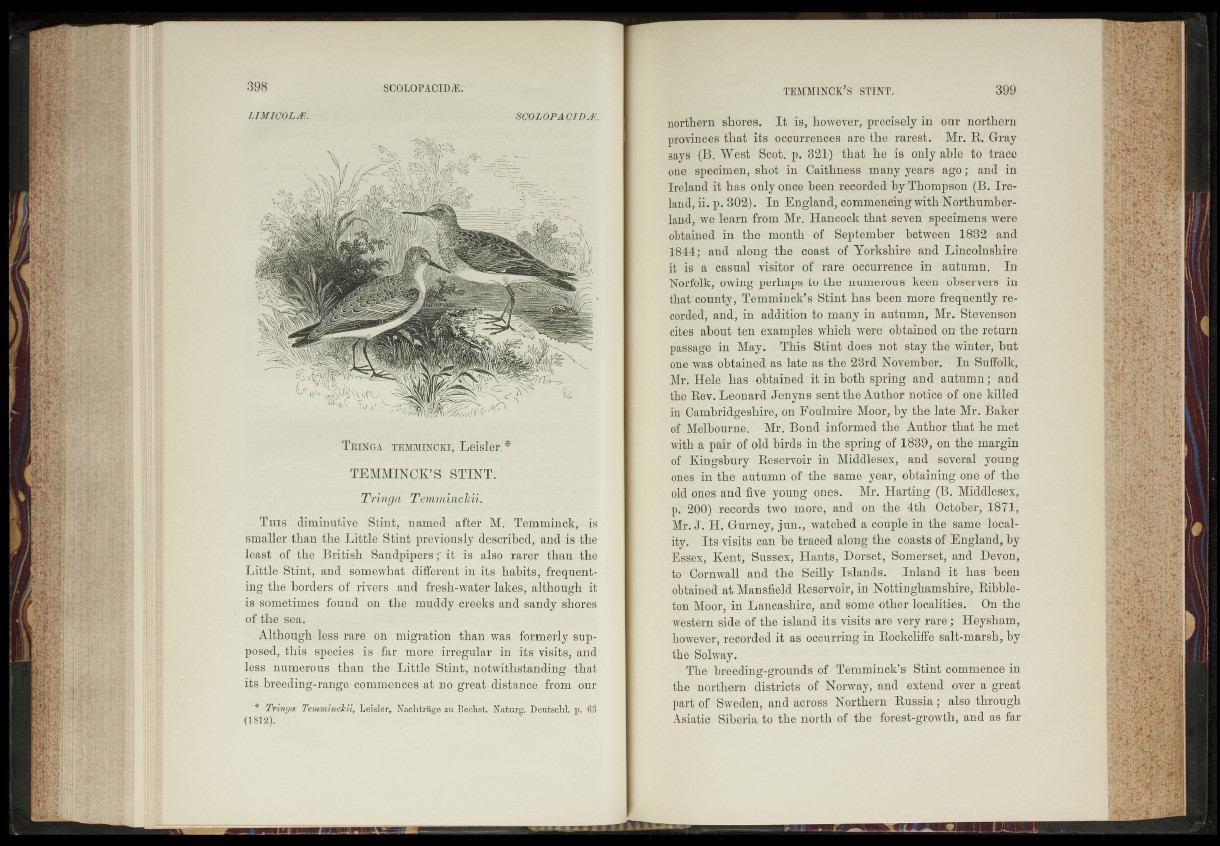
LIMICOL/F. SCOLOPA OIDJi. northern shores. It is, however, precisely in our northern
TBiN^’SiratiNeKi, Leisler:*
TEMMINCK’ S-sBTINT:.'
:Trpngaf Temfrkn<pfk%% :
This diminutive Stint, named after .1^ Temminck,
smaller than the Littje Stint previously described,. and is the
least of Ijjg^JBrjtish SandpipeÄ^itfeis' also rarer- tha.n «the
Little Stint, and somewhat different in its h%bits, frequenting
the borders of riveak and. fregk-water4alkies.: altfron gh At
is sometimes found on the muddymieeks and sandy.shores
of the sea,
"Äithough’fess rare on migration-- than was formerly^&nJlr
posed/ this « sgeoien:<y^- far - more - irregular in its; visits, and
less numerous than the Little Stint, notwithstanding that
its breeding-range commences:at no great distance'from our
* • Tringa Temminclcii, Leisler, Nachträge an Beehst. Naturg. Dentschl. p. 63
(1812)--,
provinces that its occurrences are the rarest. Mr. R. Gray
says (B. West: Scot.'p. 321) that he is only able' to trace
one , specimen, shot *kt Caithness many years ago; and in
Ireland it lias only once been recorded fey^hompson (B. Ireland,
P f 302) . In England, commencing with Northumberland,
we learn from Mr. Hancock-that seven specimens were
obtained in the" month ©f September between 1832 and
1844; and along the coast of Yorkshire and Lincolnshire
it is a casual visitor of- rare occurrence in autumn. In
Norfolk, owing perhaps to -the- numerous" ‘keen dbservers in
that county, Temminck’s Stint has been"more frequently recorded,
and, in addition to many in autumn, Mr. Stevenson
cites abd>ut ten examples which were obtained on-the return
passage in May. This Stint does not stay the winter, but
one was obtained as late as the 23rd November. - I n Suffolk)
MitHele has .obtained'it in both spring and autumn;' and
the Bev. Leonard Jenyns sent the 'Author notice of one killed
msCambridgeshire, feh^B%ulmire Moor,, by the late Mr. Baker
of /Melbourne. ' Mrv/Bond - informedSfhe^ -Author that he met
with a' pair of old birds in the spring'of 1839, on ,the margin
of&Kingsbury Beservbir in Middlesex, and several young
ones fei the -autumn of;the> same^year, obtaining-one of the
Olf hues'and «five young ones. Mr. Harting (B. Middlesex^
p. 200) ^records 4wo more, and on-rthe- 4 th - October, 1871,
■Mr. JrH . Gurney, jun.,: watched-a couple'in the same locality?"
:Its>-viSits can be-tmced?along the’ coasts of England, by
Essex, Kent; Sussex, Hanfs,-lDq^fetf 'Somerset, and Devon)
tobGornwall and the ?Sei% -Islands.' -Inland it has been
obtained at Mansfield- Beservblffih’ ottinghamshirer Bibble -
toiTMoor, in Lancashire, and gome1 other localities; On the
western side of the island its visits are" v'ery-^rej- ' Heysham,
however," recorded it as occurring in; Bbckeliffe salt-marsh, by
the-'Selway; m
.^TKe- breeding-grounds of Temminck’s Stintbommehce" in
thei* northern-districts v‘of "Norway, 'and extend over ’a "-great
part oh Sweddny and, across Northern Bussia ; also through
Asiatic Siberia tb %he:n |rth of the forest-growth, and as far